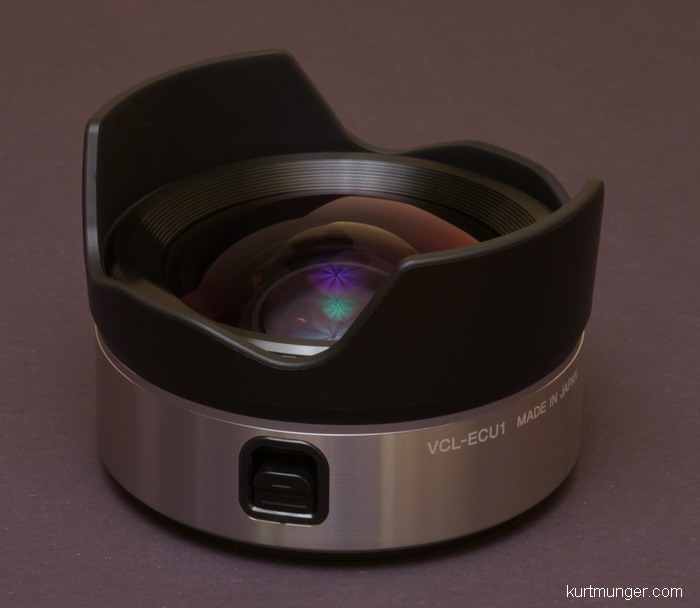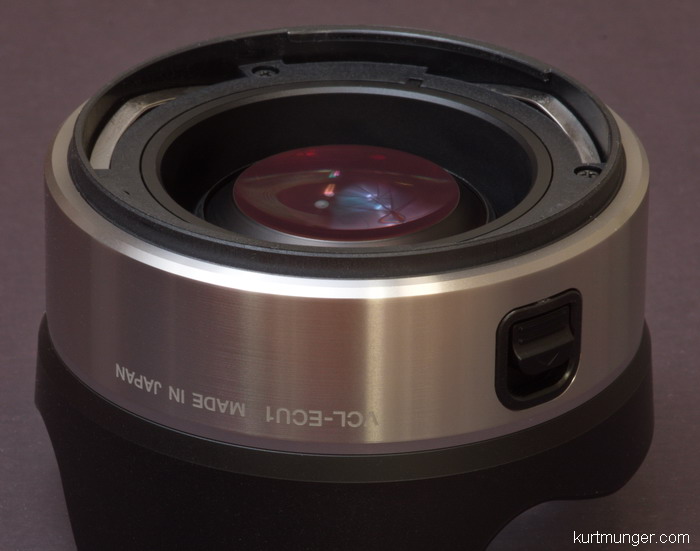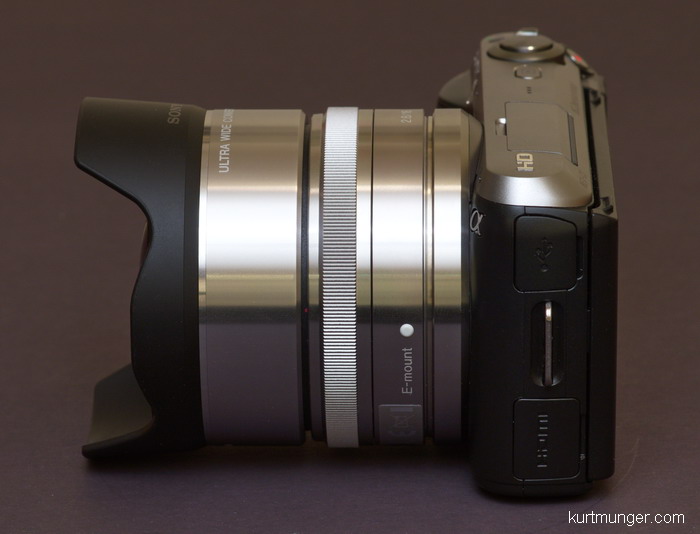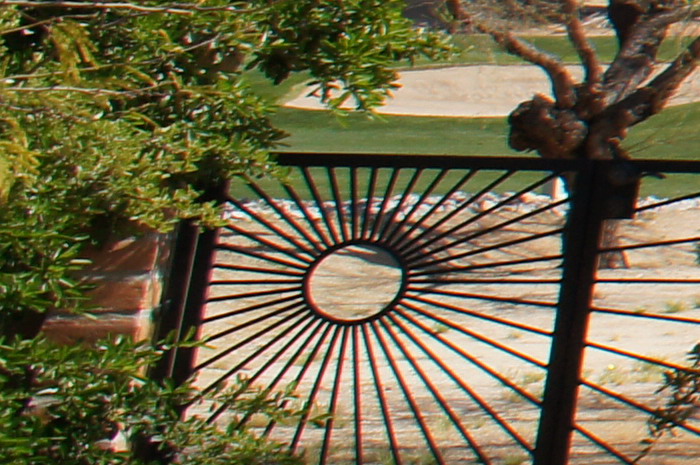 |
| Box and contents |
The Sony NEX-C3 and Sony 16mm F/2.8 lens was used for this review. For a better understanding of terms and methods used in this review, go here. The usual center, mid-section and corner crops are located at the very bottom of the page.
There are two versions of this converter, the VCL-ECU1, for the 16mm lens, and the VCL-ECU2 for both the 16mm and 20mm. The VCL-ECU1 is no longer available from Sony and many other retail outlets. Links in the review are for the updated version.
Introduction.
Sony designed the NEX 16mm F/2.8 and 20/2.8 pancake lenses to be used with a couple of different converters, one of which is the ultra wide angle 0.75x, the other is a fisheye. This converter on the 16/2.8 gives you the same coverage as 18mm in full frame (135 film) format; that’s pretty wide! With the 20/2.8, the full frame capture area is 24mm, wide, but not super wide. The made in Japan converter uses the focusing of the host lens, so there are no contacts for communication with the camera, and the EXIF data displays 16/20mm, so the camera doesn’t know it’s mounted.
Fit and finish: the same as other Sony NEX lenses. It seems like Sony is using the same outer ‘aluminum alloy’ material, and the color matches the silver lenses perfectly. The converter comes with a built-in hood, and can’t be removed.
The front and rear covers are non-traditional for Sony lenses; they’re just plastic covers the fit snugly in place.
Light loss when using the converter is approximately a half stop, so the minimum equivalent aperture would be around F/3.2-3.5.
Mounting. The converter mounts to the front of the 16/20mm lenses just outside of the filter threads. You can mount it upside down if you want, meaning the same as a bayonet type hood. It doesn’t seem to make any difference in image quality. There is a red dot on the converter that you match up with a red dot on top of the lens, that way you don’t have to worry about mounting it wrong.
Requisite product shots.
 |
| Bulbous front element with built in hood |
 |
| Back side, no contacts |
 |
| Mounted on Sony NEX-C3 with 16mm pancake lens |
General information and specifications.
|
Lens
|
|
|
Box contents
|
Front cover, rear cover, clam-shell carrying case and users manual.
|
|
Cost
|
Approximately $160
|
|
Build quality
|
Very good
|
|
Additional information
|
Introduced in 2010, but were not widely available (in US) until mid 2011.
|
Specifications below
|
|
|
Optical configuration
|
3 elements in 3 groups, multi-coated.
|
|
Angle of view
|
0.75x the host lens, or 18mm and 24mm in full frame or 135 film format.
|
|
Aperture
|
N/A
|
|
Full frame and APS-C
|
|
|
Depth of field and focus scales?
|
N/A
|
|
Minimum focus, image plane to subject
|
About 6.5″ (165mm)
|
|
Minimum focus, end of lens barrel to subject
|
About 3.25″ (82mm) distance is from longest hood protrusion.
|
|
Hard stop at infinity focus?
|
No
|
|
Length changes when focusing?
|
N/A
|
|
Focus ring turns in AF?
|
N/A
|
|
Filter size
|
Will not accept filters.
|
|
Filter ring rotates?
|
No
|
|
Distance encoder?
|
No
|
|
Max magnification
|
About .078x, or 1:13
|
|
Min. F/stop
|
N/A
|
|
Sony teleconverter compatible?
|
No
|
|
Length changes when zooming?
|
N/A
|
|
Dimensions WxL (my measurements)
|
2.6″ x 1.57″ 66mm x 40mm.
|
|
Maximum extended length (my measurements)
|
N/A
|
|
Weight bare (my scale)
|
4.5oz (128g)
|
Optical qualities summary.
Lens flare/ghosting. Fair to poor control. I see some multi-colored ghosts and dots, (mostly green), when bright lights are near or inside the image.
Color fringing (CA). Lateral color fringing control is below average. Expect color fringing (mostly magenta) all along the sides of the image. See sample farther down the page.
Bokeh. The same as the host lens. Don’t worry about background blur with this lens, unless you focus on something very close with a large aperture.
Color. Same as other Sony lenses.
Close up filter. N/A
Coma. Small amount in the extreme corners, the same as the host lens.
Regular filters cannot be used, and there is no rear gel slot.
Filter size. N/A
Distortion example directly below.
 |
| Wave type distortion like the host lens |
Distortion is complex wave type, and pretty much impossible to straighten out completely. It’s the same type as the 16mm lens, but maybe a bit more pronounced.
Light fall-off samples.
Light fall-off is not something to worry about on this lens, it’s the same as the host lens.
Color fringing.
 |
| Strong color fringing, F/8 |
This crop comes from the last 700 pixels of the middle left side, taken at F/8. Magenta or red is very noticeable, but I also see some cyan on the opposite.
Conclusion.
The Sony VCL-ECU2 is very handy if you’re going on vacation and don’t want to take a bunch of gear, or if you want to go really wide once in a while, without the expense of an ultra wide zoom lens. With that said, the small, Sony NEX ultra wide converter turned in a pretty good performance for an add-on device, but if you look at your images at the pixel level, you probably won’t mistake it for a good ultra wide angle lens.
When using this converter, keep in mind you’ll see all the issues with the NEX 16mm and 20mm pancake lens, both good and bad, so if you’re a pixel peeper, you’ll have to decide if the compromises out-weight the convenience.
For just over a $100, I’d say this ultra wide converter is a good buy if you have the Sony NEX 16mm F/2.8 or 20mm F/2.8 lenses, or got one as a kit lens. However, if you don’t have either one, you’ll have to spend close to $360+ to go ultra wide, I probably wouldn’t do that, but that’s just me thinking out loud.
|






















